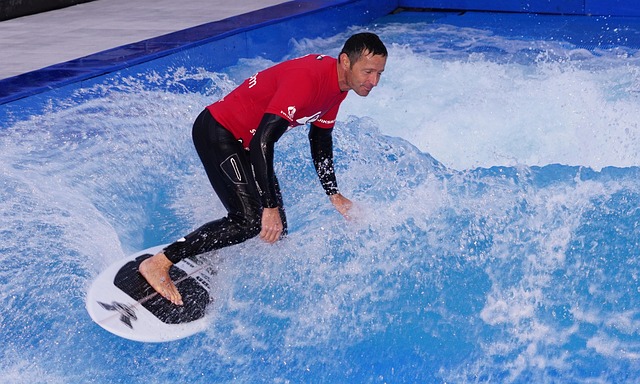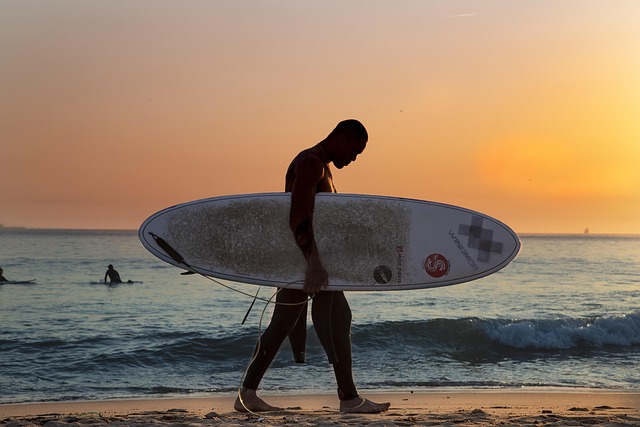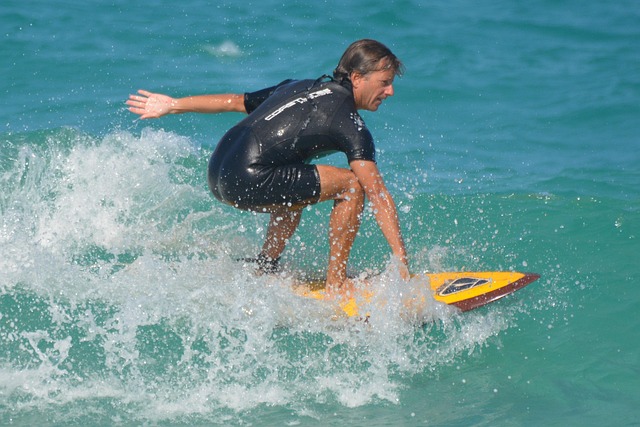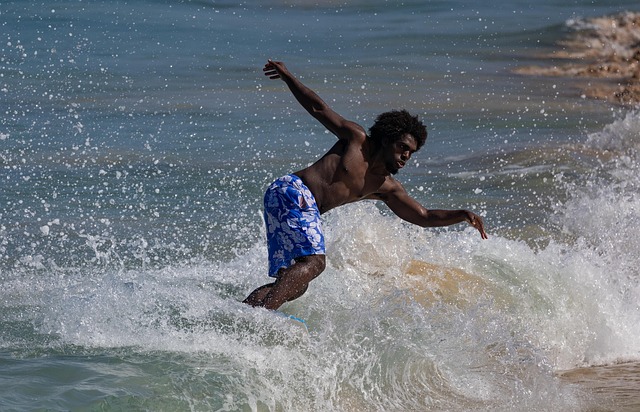For first-time surfers, understanding wave types is crucial when choosing a board. Different breaks (beach, point, reef) require specific designs. Beginners should opt for longer, wider boards with soft foam cores for stability and ease of use. All-in-one surfboards are ideal, offering versatility and consistent performance. Choosing the wrong board can hinder learning; focus on skill level and wave conditions. Universal surfboards, designed for various waves, enhance learning and skills. Proper care extends board lifespan through cleaning, waxing, storage, and inspections.
“Looking to dive into the world of surfing but unsure where to start? Choosing the right surfboard is key, especially with varying wave types. This comprehensive guide will suit all beginner surfers, no matter the ocean conditions.
We’ll navigate through understanding different wave types, uncovering essential features to seek in your first board, and highlighting benefits for universal surfboards. Avoid common mistakes, gain expert advice, and explore real-life experiences.
By the end, you’ll be equipped with knowledge to select and maintain your ideal surfboard for a lasting, enjoyable surfing journey.”
Understanding Different Wave Types: A Beginner's Guide

For a beginner looking to pick their first surfboard, understanding different wave types is crucial. The ocean presents a diverse range of waves, each with its own characteristics and behaviours. These can generally be categorised into three main types: beach breaks, point breaks, and reef breaks. Beach breaks occur when waves roll in along a shallow shore, creating a smooth, long ride suitable for beginners learning to catch waves. Point breaks, on the other hand, form as waves break over a submerged point or headland, offering longer rides with more opportunity for manoeuvres. Reef breaks are created by underwater reefs or rocks, resulting in powerful, hollow waves that can be challenging but also provide some of the best surfing conditions.
Each wave type demands a slightly different surfboard design to suit its unique conditions. Beginners should consider their local wave conditions and choose a board that’s designed to handle those specific types. For instance, a wider, longer board is ideal for gentle beach breaks as it provides stability and buoyancy. Conversely, shorter boards with more rocker (flex) are better suited to point breaks, enabling quicker turns and tighter turns.
Key Features to Look for in a Surfboard for Beginners

When choosing a surfboard for beginners, several key features should be at the forefront of your decision-making process. First and foremost, consider the board’s size and shape. A longer board with a wider tail offers stability and makes catching waves easier, which is perfect for newcomers to the sport. Look for boards between 7 to 9 feet in length, as this range provides an excellent balance between maneuverability and buoyancy.
Additionally, beginners should opt for boards with soft or intermediate foam cores. These materials are lighter and more forgiving than their stiffer counterparts, making them less likely to snap upon impact with the water or during falls. A smooth, rounded nose and a fin setup that includes a single center fin are also ideal, as these designs reduce the learning curve by promoting smoother turns and easier maneuvers in various wave conditions.
Benefits of Using a Board Suited for All Wave Conditions

For beginners looking to explore the world of surfing, choosing the right surfboard is essential. A board designed to handle all wave types offers several advantages. Firstly, it provides versatility, allowing surfers to enjoy various conditions without needing different boards for each type of wave. This is particularly beneficial for those new to the sport who want to develop their skills across different environments.
Such a surfboard ensures consistent performance and stability, enabling beginners to focus on learning techniques rather than adjusting to board differences. It also saves on space and financial resources, as one board can adapt to both small, gentle waves and larger, more challenging ones. This all-in-one approach streamlines the surfing experience, making it easier for novice surfers to gain confidence and improve their skills on a single, versatile board.
Common Mistakes to Avoid When Choosing Your First Surfboard

When choosing your first surfboard, many beginners make mistakes that could hinder their learning experience and overall enjoyment of the sport. One common blunder is selecting a board that’s too long or heavy for their size and strength. A surfboard that’s too big can be difficult to maneuver, making it harder to stand and catch waves. Conversely, a board that’s too short or light might not provide enough stability, especially in choppy conditions.
Another mistake to avoid is picking a board based solely on aesthetics or trendy designs without considering its performance characteristics. Beginners should look for boards designed for their skill level and wave conditions they typically surf. A wide range of options, like fish boards for smaller waves and longboards for cruising, cater to different needs. Remember, the right surfboard for beginners is one that offers a balance between ease of use, stability, and maneuverability.
Expert Tips for Getting the Most Out of Your Surfboard

Choosing the right surfboard is just the first step; mastering it requires knowledge and practice. For newcomers, a crucial tip is to start with a board that’s versatile, suited for various wave types. This way, you can focus on learning essential skills like paddling and catching waves rather than worrying about board performance.
Consider your experience level and surfing environment when selecting. A beginner-friendly board may have more buoyancy and a wider shape, making it easier to paddle and stay afloat. Remember, the goal is to find a balance between stability for learning and maneuverability as you improve.
Case Studies: Real-Life Experiences with Universal Surfboards

Universal surfboards, designed to be suited for all wave types, have proven their value through various case studies and real-life experiences. One notable example involves beginners who have found success with these boards on both gentle entry waves and more challenging conditions. A study conducted in Hawaii revealed that new surfers were able to stay out longer and improve their skills faster due to the adaptability of a universal surfboard, making it an ideal choice for those just starting out.
Another case study focused on a surf school in California, where instructors observed significant progress among students using these versatile boards. The ability to adjust fin configurations and rocker profiles allowed surfers to fine-tune their performance based on wave conditions, providing a more enjoyable and effective learning experience. This adaptability has not only made universal surfboards popular among beginners but also advanced surfers looking for a board that can handle diverse waters.
Maintenance and Care Tips for Extending Your Surfboard's Lifespan

To ensure your surfboard lasts as long as possible, especially if you’re a beginner surfer just getting started, proper maintenance and care are essential. Begin by regularly cleaning your board with fresh water after each use to remove any salt residue or sand that can damage the surface. A soft brush is ideal for this task. Additionally, apply a protective wax to safeguard against water absorption and sun exposure, which can lead to warping or cracking.
Store your surfboard in a cool, dry place away from direct sunlight when not in use. Avoid stacking other items on top of it, as this can cause dents or scratches. Consider using a board bag for transport, shielding it from elements like sand and waves during travel. Lastly, inspect your board periodically for any signs of damage, addressing issues promptly to prevent them from escalating.
